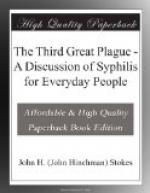temporarily out of sight, create a false sense of
security, and leave the disease to proceed quietly
below the surface, to the undoing of its victim.
Such patients get an entirely false idea of their
condition, and may refuse to believe that they are
not really cured, or may have no occasion even to wonder
whether they are or not until they are beyond help.
Every statement that can be made about the danger
of syphilis to the public health applies with full
force to the symptomatically treated early case.
Trifling relapses, highly contagious sores in the
mouth, or elsewhere, are not prevented by symptomatic
treatment and pass unnoticed the more readily because
the patient feels himself secure in what has been
done for him. In the first five years of an inefficiently
treated infection, and sometimes longer, this danger
is a very near and terrible one, to which thousands
fall victims every year, and among them, perhaps,
some of your friends and mine. Dangerous syphilis
is imperfectly treated syphilis, and at any moment
it may confront us in our drawing rooms, in the swimming
pool, across the counter of the store, or in the milkman,
the waitress, the barber. It confronts thousands
of wives and children in the person of half-cured
fathers, infected nurse-maids, and others intimately
associated with their personal life. These dangers
can be effectively removed from our midst by the substitution
of radical for symptomatic methods and ideals of cure.
A person under vigorous treatment with a view to radical
cure, with the observation of his condition by a physician
which that implies, is nearly harmless. In a reasonable
time he can be made fit even for marriage. The
whole contagious period of syphilis would lose its
contagiousness if every patient and physician refused
to think of anything but radical cure.
In such a demand as this for the highest ideals in
the treatment of a disease like syphilis, the medical
profession must, of course, stand prepared to do its
share toward securing the best results. No one
concedes more freely than the physician himself that,
in the recognition and radical treatment of syphilis,
not all the members of the medical profession are
abreast of the most advanced knowledge of the subject.
Syphilis, almost up to the present day, has never been
adequately taught as part of a medical training.
Those who obtained a smattering of knowledge about
it from half a dozen sources in their school days were
fortunate. Thorough knowledge of the disease,
of the infinite variety of its forms, of the surest
means of recognizing it, and the best methods of treating
it, is only beginning to be available for medical students
at the hands of expert teachers of the subject.
The profession, by the great advances in the medical
teaching of syphilis in the past ten years, and the
greater advances yet to come, is, however, doing its
best to meet its share of responsibility in preparation
for a successful campaign. The combination of
the physician who insists on curing syphilis, with
the patient who insists on being cured, may well be
irresistible.




